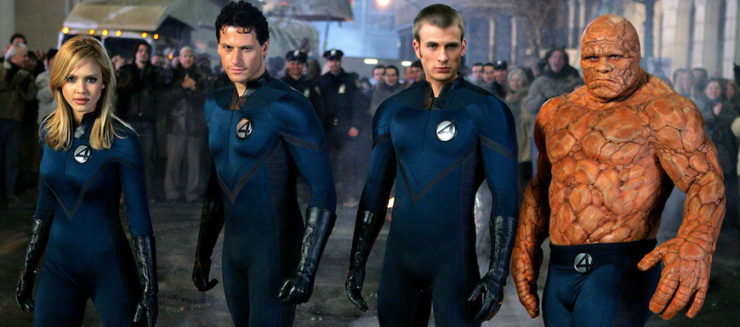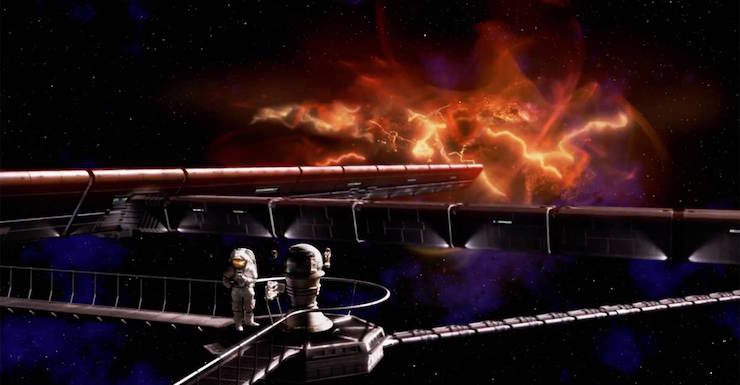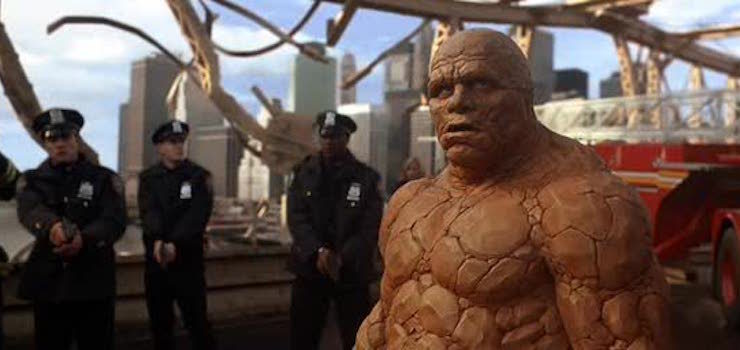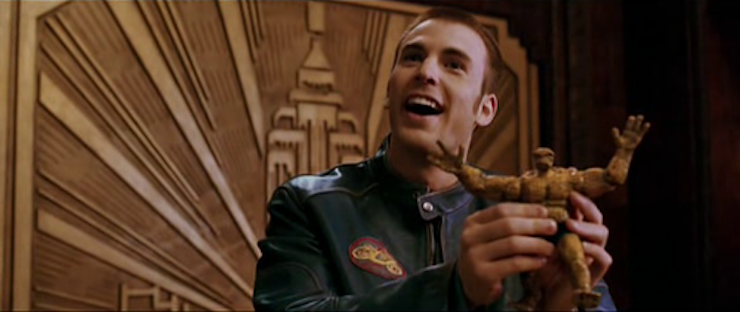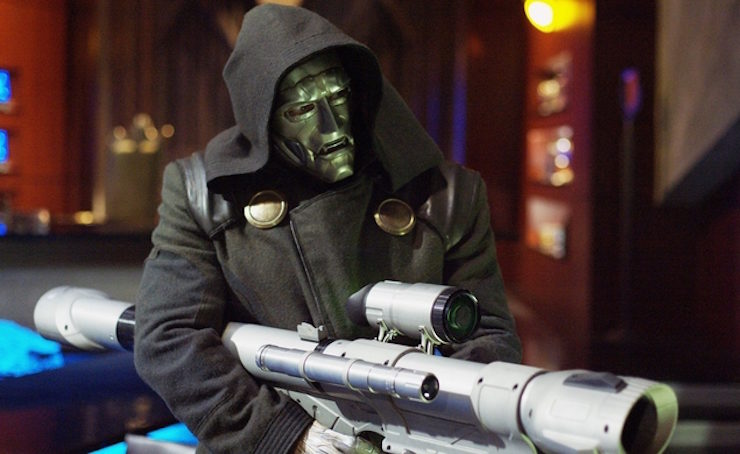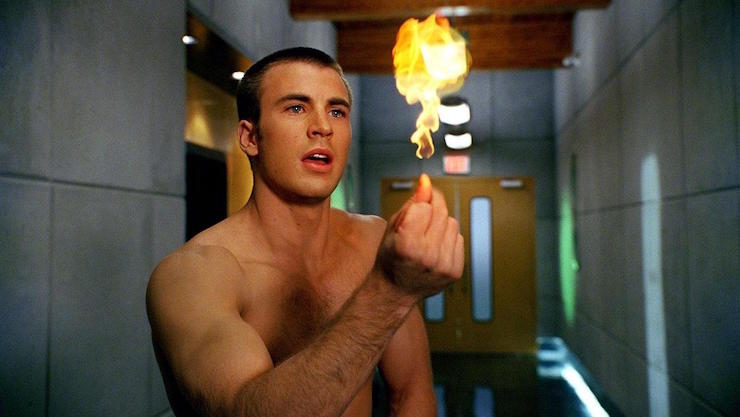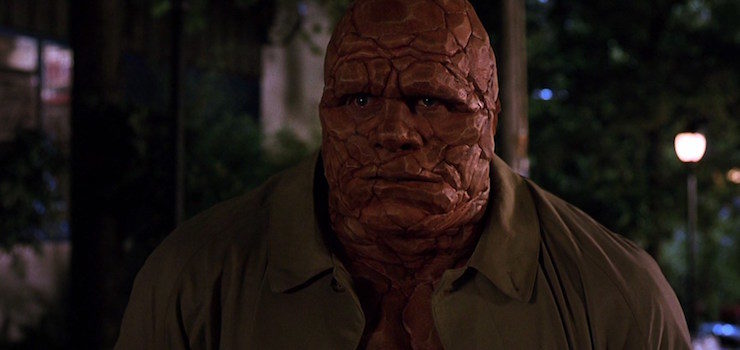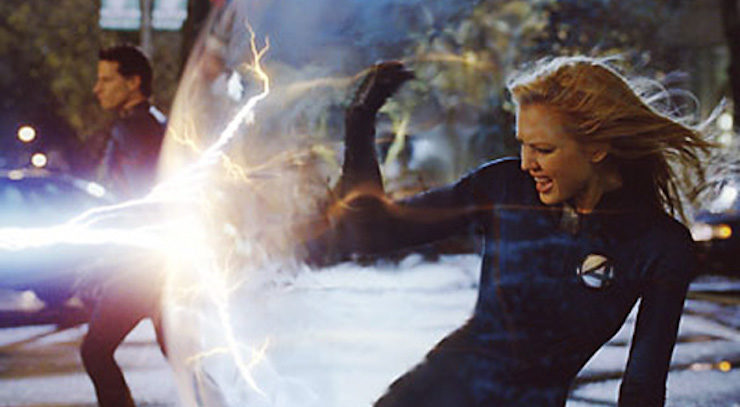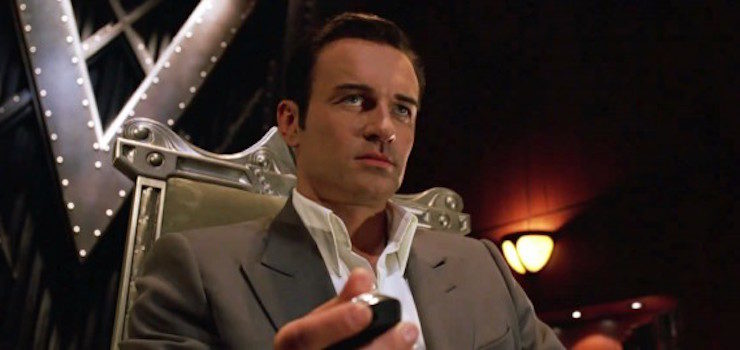Dubbed “the world’s greatest comic magazine,” Fantastic Four changed comics when it was created by Stan Lee and Jack Kirby in 1961. At the time, DC (or National Periodical Publications) was having huge success rebooting their superhero comics, with new versions of the Flash and Green Lantern and renewed interest in Batman and Superman and Wonder Woman—and they also had a huge team book in Justice League of America.
Over at Marvel (or Timely Publications), whose bread and butter was mostly monster comics at this point, they decided to cash in on the trend with their own superhero team, though this one was less like the Justice League and more of a family of adventurers, more akin to Challengers of the Unknown. They were the first of many new superheroes to debut from the company, quickly followed by the Hulk, Spider-Man, Iron Man, Thor, Daredevil, and more, including another couple of team books, X-Men and Avengers.
Even though the Fantastic Four were eclipsed in straight-up popularity by Spider-Man in the 1960s and 1970s, the X-Men in the 1980s and the 1990s, and the Avengers in the 2000s and 2010s, the FF always remained the rock-solid foundation of the Marvel age of heroes.
In comics, anyhow. In movies, not so much.
The history of the FF in comics has always been steady and stalwart. It was the book that Lee and Kirby stayed on together the longest, with more than a hundred issues done together. So many of Marvel’s most iconic heroes and villains came out of the FF comic, from Dr. Doom to the revival of the 1940s character Sub-Mariner to the Black Panther to Galactus and the Silver Surfer.
But it’s the main foursome themselves who remain the primary part of the team’s appeal: Reed Richards, the brilliant scientist. Susan Storm Richards, his wife and support, who went from being the “girl hostage” in the 1960s to becoming the most capable and powerful member of the team. Johnny Storm, the hot-headed Human Torch. And Ben Grimm, the tragic strongman who remains trapped in a hideous, rocky form. (The team would have lots of other substitute members over the decades, from Giant-Man to Luke Cage to She-Hulk to Crystal to Ant-Man to Storm to the Black Panther and more.)
Two aspects of the FF stood out in 1961 that set the tone for future Marvel characters. The first was the team eschewing the whole concept of the secret identity, the first major heroes to do that. They all have codenames—Mr. Fantastic, the Invisible Woman (previously the Invisible Girl), the Human Torch, the Thing—but everyone knows who they really are. They’re completely public in a way that superheroes never were at the time, and which you only see more commonly in the last twenty years or so.
Buy the Book
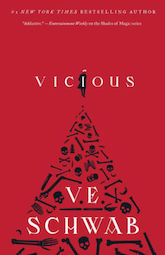

Vicious
The other is embodied in the Thing (and also in Cyclops of the X-Men): the notion of powers as tragedy. The Thing doesn’t transform into the Thing, he’s always the Thing. (Unlike one animated spinoff, anyhow…)
Many of the finest names in comics have worked on the FF over the years. John Byrne’s brilliant run from 1981-1986 was as definitive a run as Lee and Kirby’s (and as seminal in its own right as Walt Simonson’s contemporary run on Thor), and folks like Roy Thomas, Len Wein, Marv Wolfman, Steve Englehart, Karl Kesel, Jonathan Hickman, Chris Claremont, Simonson, Jeph Loeb, and especially Mark Waid did some of their best work on the flagship title.
After the disastrous 1994 movie produced by Roger Corman, Marvel paid through the nose to get the negatives back and sell the rights to 20th Century Fox, who then took ten years to finally get an FF movie made. (The executive producer of the 1994 film, Bernd Eichinger, still has a producer credit on this one.) The film went through screenwriters and directors like stoners through potato chips: Chris Columbus, Michael France (who co-wrote the Ang Lee Hulk and the Thomas Jane Punisher), Sam Hamm (who co-wrote the Tim Burton Batman), Sam Weisman, Raja Gosnell, Peyton Reed (who would go on to direct Ant-Man and Ant-Man & the Wasp), Mark Frost, Tim Story, and Simon Kinberg (one of the writers and producers on Fox’s X-Men films). The final writing credit went to France and Frost, though Kinberg did uncredited work on it, and Story finally settled in as director.
The cast included Jessica Alba, a controversial bit of casting as Sue, as well as Chris Evans (who would go on to play the definitive Captain America from 2011 to the present day) as Johnny, Ioan Gruffudd as Reed, longtime comics fan Michael Chiklis as the perfect Ben, and Julian McMahon as Victor von Doom.
“It’s clobberin’ time!”
Fantastic Four
Written by Michael France and Mark Frost
Directed by Tim Story
Produced by Avi Arad and Bernd Eichinger and Ralph Winter
Original release date: July 8, 2005
Reed Richards and his best friend Ben Grimm go to Von Doom Enterprises in New York to meet with Victor von Doom, their old college buddy, who has a thirty-foot statue of himself in the lobby of the building. Reed’s theory is that a storm of cosmic rays passed by Earth billions of years ago and was the catalyzing event for life on the planet. (Hilariously, this is also the plot of the classic Doctor Who episode “City of Death,” only there it was a Jagaroth space ship exploding.) Another such storm will pass by Earth soon, and Reed wants to study it using the Von Doom orbital platform. Reed can’t do it himself because he’s bankrupt, and NASA has already turned him down.
However, von Doom agrees, for 75% of the profits. He puts genetic scientist Susan Storm in charge on his end—Sue is Reed’s ex, and Victor has the hots for her also. Reed wants former astronaut Ben to pilot the shuttle, but von Doom already has a pilot: Sue’s brother Johnny Storm, who washed out of NASA under Ben’s watch when he crashed a flight simulator. Johnny is willing to let Ben be copilot, though.
Victor joins the expedition, and the five of them arrive on the platform. (Is there nobody up there normally? Who maintains it?) Victor tries to propose to Sue, but before he can, the cloud accelerates while Ben is EVA placing Reed’s sensors. Ben is hit hardest by the cosmic storm, but they’re all affected—except for Victor, who lowers the shield to protect himself while the others are on the outer edge of the platform trying to rescue Ben.
They are brought back to Earth, with the four who were outside the shield left in quarantine at a private hospital in upstate New York near a mountain. Ben tries to get Reed to rekindle his romance with Sue, while Johnny decides to break quarantine and go snowboarding with a nurse. Meanwhile, Von Doom Enterprises took a huge stock hit after the fiasco on the platform, and the board of directors gives Victor a week to right the ship.
Reed, Sue, Ben, and Johnny start displaying odd symptoms. Johnny catches fire, Sue turns invisible temporarily, Reed is able to stretch his arms like taffy, and Ben transforms into a giant rocky creature. Ben breaks out through a wall and heads back into New York City to talk to his fiancée Debbie. However, one look at Ben’s new form and she runs screaming.
Ben goes to the Brooklyn Bridge to brood. He stops a jumper from committing suicide, but the chaos caused by his rescue results in a massive pileup—including an oxygen canister exploding, causing a major fire. A fire truck attempts a rescue, but also crashes. Reed, Sue, and Johnny’s cab happens to be on the Brooklyn Bridge by a startling coincidence (even if they were definitely going to Brooklyn from von Doom’s private hospital, there’s a dozen other routes they could take that wouldn’t involve that iconic bridge). They’re able to rescue the firefighters and bystanders, Johnny by absorbing the flames, Sue by generating an invisible forcefield to contain the fire, Ben by pulling the fire truck from the edge of the bridge, and Reed by stretching far enough to catch a falling firefighter before he crashes into the East River.
While the cops are all set to arrest the four of them, the crowd and the firefighters cheer them, leading the cops to put their guns down. The media dubs them the Fantastic Four, and they become instant celebrities.
Unfortunately, they don’t know what the cosmic storm actually did to them. Reed takes them to his combination home/lab in the Baxter Building, where they’re warmly greeted by Jimmy the Doorman, as well as mailman Willie Lumpkin, who looks just like Stan Lee, and who hands Reed a whole mess of bills labelled “FINAL NOTICE.”
While Reed does multiple tests on all four of them, Victor notices that he, too, has been affected, as his skin is turning into metal, and he also has some control over electricity. He also has lost his company, as the board of directors has ousted him thanks to the failure of Von Doom Enterprises’ IPO. Victor takes revenge on the board by killing the chair in the parking lot.
Reed has come up with a possible way to reverse their mutations, but he’s not sure it’ll work, and is worried that it will kill them. Sue is frustrated with how indecisive he is, and she’s not just talking about science. Johnny is chafing under being forced to stay inside, and has started using their fame for marketing purposes.
Johnny goes to a motorcross event and gives an impromptu press conference, giving himself and the other three nicknames. Reed, Sue, and Ben go to the arena to remonstrate with him, and they argue publicly and loudly.
Victor has bugged the Baxter Building, and he uses the fact that Reed and Sue are taking steps to get back together to sow doubt in Ben, convincing him that Reed is too busy mooning over Sue to work on his cure. Reed, still not sure the cure will work, tests it on himself—and it doesn’t work because he didn’t use enough power.
Ben goes to his favorite bar in Brooklyn (in the comics, he’s from the lower east side, which makes him the first of two Jack Kirby creations to be moved from the LES to Brooklyn for no compellingly good reason, the other being Steve Rogers in Captain America: The First Avenger six years hence). He meets a blind woman named Alicia, who is fascinated by him, and the feeling is mutual.
While Reed is recovering and Sue is caring for him, Victor convinces Ben to return to the Baxter Building. Victor increases the power as Reed theorized, but also exposes himself to more cosmic rays. Ben is cured, and Victor is now more powerful. Too late, Ben realizes his mistake, and Victor—whose skin is now almost entirely metal—rewards him by throwing him into a wall, and says, “One down, three to go.”
Victor then defeats Reed and kidnaps him to his own nearby office and, after putting a metal mask on to cover his increasingly disfigured face, fires a heat-seeking missile at the Baxter Building. Johnny is able to divert it by flying through the air while flamed on, eventually diverting it to a garbage scow.
Thinking Johnny to be dead, Victor says, “Two down,” even though he’s actually defeated three of them. Sue arrives at his office and frees Reed while invisible, but Victor interrupts her and they fight. Then Ben arrives, all rocky again, as he put himself back in the chamber to get his strength back in order to take Victor down. Now the four of them face off against Victor on the streets of New York. At Reed’s direction, Johnny superheats Victor, with Sue’s force field keeping the fire contained to just Victor. Then he has Ben kick open a fire hydrant, and Reed uses his own body as a hose to douse the white-hot Victor, freezing his metal form in place.
The Fantastic Four hold a celebration on a boat. Alicia is there, Ben’s arms around her, the latter more philosophical about his transformation. Reed proposes to Sue, and she accepts. Meanwhile, Victor is placed in a cargo crate on a ship bound for his home country of Latveria.
“Flame on!”
This movie and its sequel have come under tremendous amount of fire, and while some of it is deserved, the movie has two very big things going for it: their names are Chris Evans and Michael Chiklis.
Honestly, I remember my first thought after seeing this movie thirteen years ago was that I wanted the next movie to be called Strange Tales (a title that featured the Human Torch and the Thing at various points in the 1960s and 1970s) and only feature Chiklis and Evans, with Reed and Sue off on their honeymoon.
Chiklis apparently lobbied to play Ben Grimm, and he’s letter perfect in the role, from his easy friendship with Ioan Gruffudd’s Reed to his equally easy friendship with Jessica Alba’s Sue to his war of words and deeds with Evans’s Johnny to his frustration with being the Thing. The moment when he can’t pick Debbie’s discarded engagement ring up off the pavement because his fingers are too big is just heartbreaking, and Chiklis does an amazing job of selling Ben’s anguish through the metric shit-ton of latex he’s covered in.
Anybody who’s followed the Marvel Cinematic Universe knows the greatness of Evans. If Robert Downey Jr.’s Tony Stark is the heart of the MCU, Evans’s Captain America is the soul. So it’s even more impressive to see him in this role that’s 180 degrees from Cap, an adrenaline junkie who jumps into being a superhero and a celebrity with both feet. Evans is a pure delight, and he and Chiklis make a superlative combination.
It’s really too bad they’re stuck in this movie.
So many of Marvel’s heroes have origins that are very much tied to the time in which they were created, whether it’s the basic notion of radiation = magic to writers and readers who didn’t know that much about radiation, or the specific things like the Hulk’s origin being tied to bomb testing (and the Cold War, as the test is sabotaged by a Soviet agent), Iron Man’s being tied to the fighting in Southeast Asia, and the Fantastic Four’s being tied to the space race of the 1960s.
As a result, the team’s origin needs updating when retold for a time that isn’t pre-1969, and the attempt here is—okay? Like the 1994 film, they make it a specific cosmic event that they investigate and that gives them powers. And unlike the comics and the 1994 film (but like the 2015 film that we’ll cover down the line) they give Sue and Johnny actual reasons for being on the mission, since it never made any kind of sense that the mission commander’s girlfriend and kid brother would go on a spaceflight just to tag along.
But while the basic notion of them going to an orbital platform to study a cosmic ray cloud and Things Go Horribly Wrong is a good one, the execution is botched in a number of ways.
The first is in the casting of the other two heroic leads, as Gruffudd never once convinced me that he was playing Reed Richards. I instantly bought Chiklis and Evans as their characters, but Gruffudd mostly just stared wide-eyed at things and muttered his lines and stumbled through the entire production. (At least his stretching looks more or less convincing, unlike what had been done ten years previously in both the 1994 FF film and the 1996 Generation X TV movie.)
Alba is better as Sue, as she at least sometimes gets things right (particularly when she berates Johnny for being an ass, as she sounds just like an older sister). Having said that, there are way too many situations that are contrived for the express purpose of getting Alba to wear as little clothing as possible, and it’s tiresome. (Especially since—except for a brief, awful period in the 1990s when Tom DeFalco and Paul Ryan were on the book—Sue has never been a sex symbol type of character.)
Julian McMahon does an excellent job of playing an iconic comic book villain, but the one he’s playing is Lex Luthor, which is a problem insofar as he’s been cast to play Victor von Doom. It’s frustrating, because this version of von Doom makes a much better Luthor than Gene Hackman, Kevin Spacey, or Jesse Eisenberg.
But turning Victor into an evil industrialist just never feels right. Worse, the rivalry between him and Reed never feels real. The one thing the 1994 movie got right was the resentment between Reed and Victor that went back to their days in college together and the accident that scarred Victor for life. We don’t get any of that here, changing it instead to a rivalry between a successful scientist and an unsuccessful one, with Sue reduced to the prize for one of them to win.
I don’t object to changing Victor from a despot ruling a small eastern European nation to an industrialist on principle, but the change doesn’t always fit right. Worse, though, is changing Victor’s armor from something he built with his scientific genius to super powers he got the same way the FF got theirs. But Dr. Doom was never a dangerous foe because he was armored and fired blasts from his gauntlets, but rather because he is as smart as Reed.
This basic storyline could have produced a good FF film, but it’s done in by the wholesale rewriting of Victor von Doom, by disastrous casting of three of the five leads, and by a plot that is mostly just putting the pieces in place for future films.
While this movie was not a critical success, it was a commercial one, and a sequel was greenlit. We’ll look at Fantastic Four: Rise of the Silver Surfer next week.
Keith R.A. DeCandido will be reviewing the second season of Luke Cage for this site next week, and is also working on a piece on Cloak and Dagger. If you support his Patreon, you can read his takes on Black Panther, Avengers: Infinity War, Deadpool 2, and the two most recent Star Wars films.










